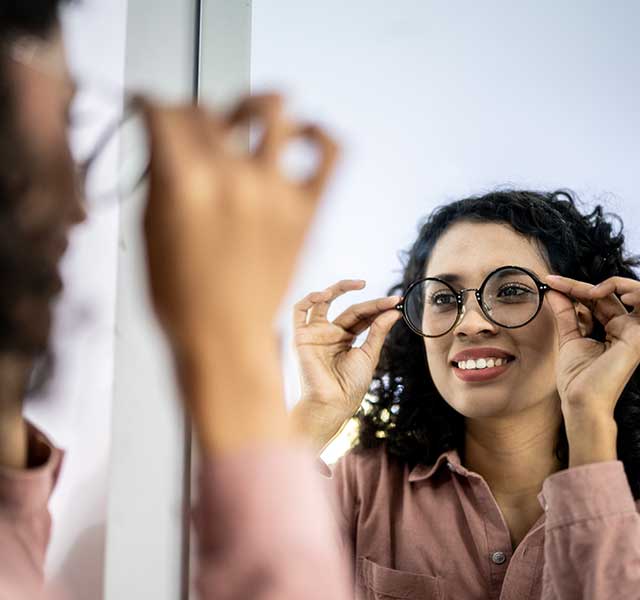If you were diagnosed with a lazy eye as a child, you may have received an eye patch, glasses or surgery to correct it. But what if you start noticing vision problems in adulthood? Is there an age limit for lazy eye treatment?
Kim Le, M.D., an ophthalmologist at Henry Ford Health, explains the options for treating a lazy eye in adults.
What Is A Lazy Eye?
A lazy eye, or amblyopia, occurs when your brain and eyes don’t develop normal connections during childhood. “Early in life, your brain must receive signals from both eyes to develop full vision,” explains Dr. Le. “But if one eye is out of alignment or can’t see clearly, your brain will start to ignore that eye. Over time, your brain will only use signals from the stronger eye, so the vision in your weaker eye worsens.”
The most common causes of lazy eye include:
- Cataracts and other eye diseases that interfere with vision in one eye
- Droopy eyelid that blocks vision
- Significant difference in your eye prescription (one eye is much more nearsighted or farsighted than the other)
- Strabismus (one eye turns outward, inward, upward or downward)
Is It Too Late To Treat Lazy Eye?
“Amblyopia is a problem with vision development, so it’s best to treat it before age 12,” Dr. Le says. “But that doesn’t mean adults cannot receive treatment for a lazy eye. Recent research shows that some adults can benefit from lazy eye treatment, whether they had treatment as a child or not.”
Adult Lazy Eye Treatments
The first step in treating a lazy eye in an adult is to find out the cause. “Sometimes another eye condition can cause vision problems, and the person assumes the lazy eye came back,” says Dr. Le. “It’s important to see a licensed eye care specialist to find out what’s affecting your vision.”
Depending on the cause, adult lazy eye treatment may involve:
Glasses
In many cases, a new pair of specs is all you need if your weaker eye isn’t seeing well. “Your vision continues to change as you get older,” says Dr. Le. “Many people are wearing the wrong glasses prescription and don’t know it. Once we get you the correct prescription, your brain can more easily use both eyes to see, and you might find that the lazy eye issues go away.”
It’s also normal to develop farsightedness as your eyes age, and it could be worse in the weaker eye. “When you reach your late 30s or early 40s, you might find it harder to see small print,” Dr. Le says. “Fortunately, it’s fixable with bifocals or reading glasses.”
Patching
Placing a patch over the stronger eye is an effective treatment for children with a lazy eye. And it could help some adults, too.
“Patching helps your brain use the weaker eye without the stronger one taking over,” says Dr. Le. “This therapy is best in younger patients because their brains are still forming. However, it’s worth trying in older patients who might need to re-train the lazy eye.”
Cataract surgery
If your vision is getting blurrier in one eye, it may not be a lazy eye at all. In many cases, a cataract could be the issue. Cataracts are a common eye problem in older adults, gradually leading to hazy or blurry vision.
“Your ophthalmologist can check your eyes for cataracts, which cause a cloudy area in your eye’s lens,” says Dr. Le. “Without treatment, cataracts can eventually cause vision loss. Cataract surgery is a safe and effective way to preserve your vision.”

Eye Care At Henry Ford
Strabismus surgery
Strabismus, or an eye misalignment, is a common cause of a lazy eye. If you had strabismus surgery as a child, you might need another surgery years later.
“Sometimes strabismus can come back years after treatment,” Dr. Le says. “If one eye isn’t pointing forward, your brain will start to ignore it, and the lazy eye can return in adulthood.”
Fortunately, treatment is available for adult strabismus. “If your eye starts to turn again, we can perform surgery to bring it back into alignment. Strabismus surgery is safe and effective for adults, and the recovery time is fairly short.”
Eyelid surgery
Eyelid drooping, or ptosis, is a common problem in adults. Over time, gravity pulls on the eyelids, blocking all or part of your vision. If your eyelid blocks a previously corrected lazy eye, your brain may stop using that eye again.
“Eyelid lift surgery can correct ptosis, and we often recommend it if the eyelid interferes with your vision,” says Dr. Le. “Your ophthalmologist may refer you to a facial plastic surgeon who specializes in this procedure.”
Proper Eye Care Is Key
Whether you had successful lazy eye treatment before or you’re seeking treatment as an adult, an eye care specialist can help.
“Everyone needs regular eye exams, even if they have no current vision problems,” says Dr. Le. “Eye exams are the only way to detect potentially serious eye problems before they cause vision loss. Your eye care specialist can partner with you to help you achieve healthy eyesight now and for years to come.”
Reviewed by Kim Le, M.D., an ophthalmologist who sees patients at several Henry Ford Health locations throughout Southeast Michigan.



